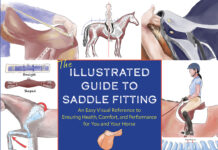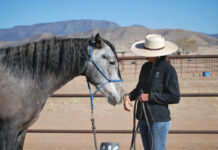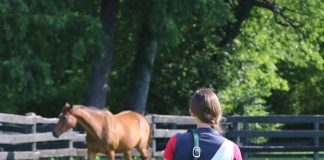You’re so excited to have a horse that your first instinct might be to pamper him, feed him treats and love on him every time you see him. That’s a perfectly normal human response to a new relationship, but it may actually undermine your partnership with your horse.

How can you ensure that you’re the leader and start off on a great path with your new mount? Understand the body language of horses and speak this new language through groundwork exercises. Groundwork can mean asking the horse to stand still, leading him or doing circling work.
Every time you work with your horse, make sure he’s following your rules and moving out of your space—constant reminders that you are the leader. Make him feel secure by giving him easy and clear rules to follow. He won’t need to look or go anywhere else; he’ll want to be with you.
Here, I’ll help you understand how horses interact with one another and explain how to communicate with your new horse. Then, I’ll help you get started with three simple yet crucial groundwork exercises. The work on the ground quickly tells your horse that you know his language and that you’re a leader he can trust.
Understanding the Herd’s Language
If you watch a large group of horses, you’ll quickly determine who is in charge. The alpha horse, or the highest horse in the pecking order, will move other horses around, claim the best spots, and get his (or her) choice of feeding locales. Horses in a herd have a linear hierarchy, meaning every horse is either dominant or subordinate to another. No two horses have equal rank.
The dominant horse also controls the resources—the food, shelter, water and shade. He gets to eat and drink first, and always gets the shady spot. He can move horses away from the resources by stretching out his neck, pinning his ears, kicking and biting. Anytime a new horse comes into the herd, the more dominant horses will herd him around to establish control. They’ll show the new horse that there’s a hierarchy in place and his initial standing is low.
Your Herd Mentality
The hierarchy and constant negotiation for a new rank is what horses know about relationships. It’s a key component to remember as you work with your new horse. In his mind, you’re a potential herdmate and are either dominant or subordinate to him, especially at the start of your relationship. Make up your mind to be the leader. The leader doesn’t want cuddles. To a horse, being that close means you don’t defend your space; he learns he could be the one in control.
I don’t like to be too up-close and personal with horses I don’t know. Of course, I like to pet on my personal horses, Dually and Eddie, but that’s a solidified relationship. In most instances, I don’t want that new horse to enter into my space. I want to have a clear boundary.
This isn’t a harsh version of dominance by a tyrant. Dominance in the herd exists to establish safety for all its members. A horse—more than any other animal in the world—wants to be accepted into the herd. He craves leadership and a sense of order. Create a confident posture and claim your position as the leader. Your confidence and gentle strength will help your horse become a well-mannered citizen.
When leadership isn’t present, a horse becomes anxious and looks around for things to worry about. If your horse runs into you or acts like you’re not even present, that isn’t an accident. He is more worried about himself than you. He is showing you that you aren’t the leader.
When you yield to your horse’s space, he is in charge. If he yields to your space, he sees you as the leader. Keep this in mind whenever you’re with your horse.
Motivation
What motivates a horse? Most people will guess food, but behaviorists will tell you that food isn’t a horse’s primary motivation. Horses aren’t reliant on other horses for food. This is what makes them very different from dogs when it comes to training. Dogs are pack animals, and are reliant on one another to work together to find food. If you turn a horse loose, he will find food. However, he is reliant on the herd for safety and comfort.
Horses find safety and comfort when there are clear rules. When groundwork is successful, the horse learns a sense of order and security. If he follows the rules, life is good and he knows he is safe with his leader. If he breaks a rule, he’ll get a correction. Comfort comes when he does the right thing; you’ll let him rest and praise him when he has followed the rules.
Putting the Knowledge to Work
On my Horse Master TV show, our cast member Margie Huoppi had a beautiful new Tennessee Walking Horse named Chance. She did everything right when horse shopping and got a mature, well-trained horse. He was beautiful, but he wasn’t acting beautifully.
Chance was pushing into her, stepping on her, and he wouldn’t work well on the longeline. She was doing groundwork, but without understanding what she was doing, she wasn’t getting the result she wanted. As she led or longed him, he crowded her and she stepped out of his space in response. She was doing groundwork this way every day and proving to Chance that he was in charge.
During the show, Margie quickly understood her mistakes and changed her body language. She armed herself with confidence and determination. Once she changed her mindset and her body language, Chance reacted and said, “Yes, ma’am.”
A horse becomes compliant and willing when he senses leadership and knows that I control his feet, his nose, his shoulder and his hip. If I can control those parts, I’m in control of the whole horse.
Let’s get started and make sure you’re in charge of your entire horse. First, outfit your horse in a rope halter and a long training lead made of high-quality, heavy rope. The heavy weight allows a slight jiggle of the rope to become a cue for your horse. I like a 15-foot rope, but 12 feet is acceptable and may be an easier length to start with. I also like to have a training flag in my hand to help extend my arm; the flag allows me to get the horse’s attention and help move him out of my space.
Standing Still
Teach your horse that he has to think and get your permission before he moves a foot: this means “stand like a statue,” not “stay approximately in the same place.”
Stand in front of your horse, facing him, turned slightly toward his left shoulder. Allow slack in the lead so that you can stand about 4 to 6 feet from his head. You don’t want to give the impression that you’re holding him still. You’re teaching him that it’s his job to stand still if you say so.
If he moves a foot or turns his head beyond the width of his shoulders, tell him that’s wrong by snapping the lead rope. If he looks away, he wants to get away.
If your timing is good—making the correction within three seconds of the step or turn of the head—you can teach your horse to stand still within just a few minutes. Timing is so important—the sooner within the three seconds that you can make a correction, the faster he will learn. Make one correction, then allow the rope to go slack and give your horse a release.
If you have an older or well-trained horse, he may stand still because that’s the easiest thing to do. You might have to practice this exercise when other horses leave for turnout—when he doesn’t want to stand still. If you have a young and fidgety horse, this exercise might be a challenge from the start.
This is the foundation for ground tying. Keep practicing in progressively more difficult locations, and see if you can move farther away or lay the lead down while holding on to the far end.
Leading Manners
To be considered well mannered, your horse should walk beside but slightly behind you. You don’t want to drag him, and he shouldn’t be in front of or dragging you. With the following exercise, you’ll teach him to walk at the speed you choose and to stay out of your space. Don’t hold him back; give him the responsibility to stay with you.
Keep your lead hand out in front of you to show your horse where to be. If his nose gets in front of your hand, turn around, snap the lead rope, and back him up. If your timing is good, he should quickly learn that there’s a forward boundary that he can’t cross. If he falls too far behind, lean in to the rope to apply pressure to let him know that’s not the right place either.
Keep practicing this exercise by doing “slow feet, fast feet.” Change your speed and make sure your horse knows the boundaries and stays right with you. Again, as long as he stays in the correct space, all will be good for him. He will understand the boundaries and feel safe.
Next, focus on turning your horse away from you as you lead. Every time you move him out of your space, you emphasize your leadership and dominance in the herd of two. You should be leading from the left, so turn him toward the right to move him out of your space.
To turn, simply look right, move your shoulders and guide hand to the right, and change the direction of your feet. Your horse should move promptly out of your space. If he doesn’t, gesture a pushing motion in the air with your hands just behind his eye. Make the turns smaller and faster. Once your horse is pivoting, he’s using the maximum effort to stay out of your space.
Circling Work
This is where the long lead is most important. You’ll drive your horse out of your space and ask him to move in circles around you.
First, understand the balance point of the horse. Visualize where the girth or cinch sits when your horse is saddled. If you step in front of that point, he will stop or turn around and move away from you. If you step behind the balance point, he moves forward and away.
To start circle work, point toward the direction you want your horse to go, and hold the end of the rope and your flag in the opposite hand. If he doesn’t move, wave your flag until he steps away, then release this pressure. You may find that one direction is more difficult for your horse than the other.
Make sure that you stay out of the kick zone. That’s why it’s important to have your flag; it helps protect your space and keeps you from getting too close. It should be expected that a horse may kick out; it’s a natural defensive behavior in response to being bossed around in a herd. Once your horse understands what you’re asking for, that should no longer be an issue.
The first stage of the circling work is just getting your horse moving in both directions at the trot. I like to teach the whoa command at this point too. I step in front of the balance point and say “whoa.” If he doesn’t stop, I bump the rope then send him the other way.
The next step is asking him to change direction without stopping. Each time you turn him, you’re controlling all parts of his body. He’ll get really focused on you and look to you to know when to turn around. To turn, step in front of the balance point and then change hands on the rope, pointing in the new direction and following through with your flag in the opposite hand.
Keep practicing until your horse gets better. The standing-still exercise becomes a ground-tying lesson. The leading work turns into having him follow you without a lead. The circling work can turn into driving him over obstacles and working without the halter and lead. There’s always something more to work on.
At first, you might not think groundwork will be fun, but once your horse catches on and follows you, it’s really fun to see what you can do! When you’ve done all the groundwork and established that relationship with your horse, you don’t even need the halter and lead because he wants to be with you. That’s your end goal, but you need to get started with the basics.
Julie Goodnight is the popular host of Horse Master on RFD-TV and travels the country sharing her horsemanship training with riders of all disciplines. She’s experienced in dressage and jumping, racing, reining, cow horse, colt starting and wilderness riding. www.juliegoodnight.com
Heidi Melocco is a journalist, photographer and therapeutic riding instructor based in Mead, Colo.
This article originally appeared in the 2015 edition of Your New Horse.






My gelding always drags behind. Never passes me. I just dont know how to change that
Thank you lots!!I needed that information. I need all the help I can get.
This is all great information! Unfortunately, I’m having trouble with flags and snapping the lead rope. He has bad memories with whips and the swishing sound and pins his ears and turns and kicks anytime I snap the lead rope or wave the flag. I don’t know how to get him to stop
[…] Read Become Your Horse’s Herd Leader through Groundwork […]